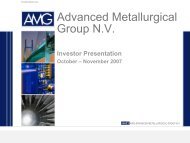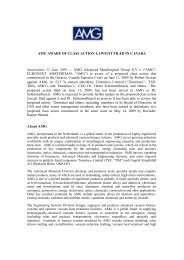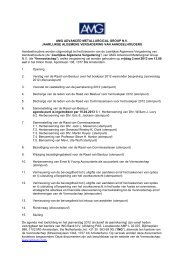C Si Ni Cr V Ti Ta Sc Li Sr Zr Fe Cu Zn Sn B Al Ce U Mn Mo Nb Sb
C Si Ni Cr V Ti Ta Sc Li Sr Zr Fe Cu Zn Sn B Al Ce U Mn Mo Nb Sb
C Si Ni Cr V Ti Ta Sc Li Sr Zr Fe Cu Zn Sn B Al Ce U Mn Mo Nb Sb
You also want an ePaper? Increase the reach of your titles
YUMPU automatically turns print PDFs into web optimized ePapers that Google loves.
value proposition to ESD’s market and improve the efficiency of alternative feedstock<br />
as an important contribution to achieving grid parity. <strong>Mo</strong>no2 is expected to<br />
increase the efficiency of cells produced from ALD’s SCU systems to above 17%<br />
at a competitive cost.<br />
Nuclear<br />
In 2010, ESD generated an increase of 100% over 2009 in nuclear order intake,<br />
albeit from low levels. In addition to the recycling of weapon grade plutonium<br />
on behalf of the United States Department of Energy in the Shaw AREWA MOX<br />
project, attractive new business was generated in the field of annealing of tubes<br />
for this segment. The division continues to develop Impermeable Graphite Matrix<br />
(“IGM”) technology in cooperation with European governmental agencies. Field<br />
testing of the IGM product and processes are expected to accelerate in 2011.<br />
Aerospace<br />
ESD is the world’s leading provider of vacuum furnaces used to produce high<br />
purity titanium and superalloys for the aerospace industry. Demand for these<br />
products increased in 2010 as the global markets began to rebound and commercial<br />
aerospace demand returned to pre-crisis levels. China, in particular,<br />
saw significant demand for high purity stainless steel and titanium vacuum<br />
systems. As the demand for more fuel-efficient aircraft continues to increase,<br />
ESD’s vacuum furnaces are well positioned to serve this market.<br />
Transportation<br />
ESD provides vacuum case hardening and heat treatment and other services<br />
through Own & Operate facilities in Germany, the United States and Mexico.<br />
These facilities utilize ESD’s proprietary vacuum heat treatment furnaces to<br />
provide tolling services to the transportation and aerospace industry. The division<br />
was able to overcome a difficult financial situation in the transportation market<br />
and grow its revenue by 55% in 2010 to $28.2 million. After years of development<br />
and expansion of the Own & Operate facilities, gross margins achieved are now<br />
fulfilling the expectations. The launch of new products and services in this segment<br />
should continue to improve margins and increase the positive contribution<br />
of the Own and Operate facilities.<br />
Outlook/Strategic Update<br />
Regional<br />
Breakdown<br />
<strong>Al</strong>though investment funding is still be dependent on global credit markets,<br />
increased demand from all segments and especially in countries like China and<br />
India provides a solid base for 2011. Innovation and expansion in the solar field<br />
will contribute to ESD’s improved performance in 2011 and beyond. The Engineering<br />
Systems Division remains well positioned for long term growth, predominantly<br />
based upon organic growth.<br />
$1.4M South America<br />
$37.1M North America<br />
$81.3M Europe<br />
$125.8M Asia<br />
$0M ROW<br />
End Market Uses<br />
/// ENERGY<br />
Solar vacuum furnaces<br />
Vacuum furnaces used to<br />
produce nuclear fuels<br />
Vacuum melting and precision<br />
casting systems for industrial<br />
gas turbines<br />
/// AEROSPACE<br />
Vacuum furnaces for titanium<br />
Electron beam coating systems<br />
for aerospace turbines<br />
/// INFRASTRUCTURE<br />
Vacuum furnaces for<br />
specialty steel<br />
/// SPECIALTY METALS & CHEMICALS<br />
Vacuum systems for high<br />
performance materials<br />
Report of the Management Board | Engineering Systems Division 29







